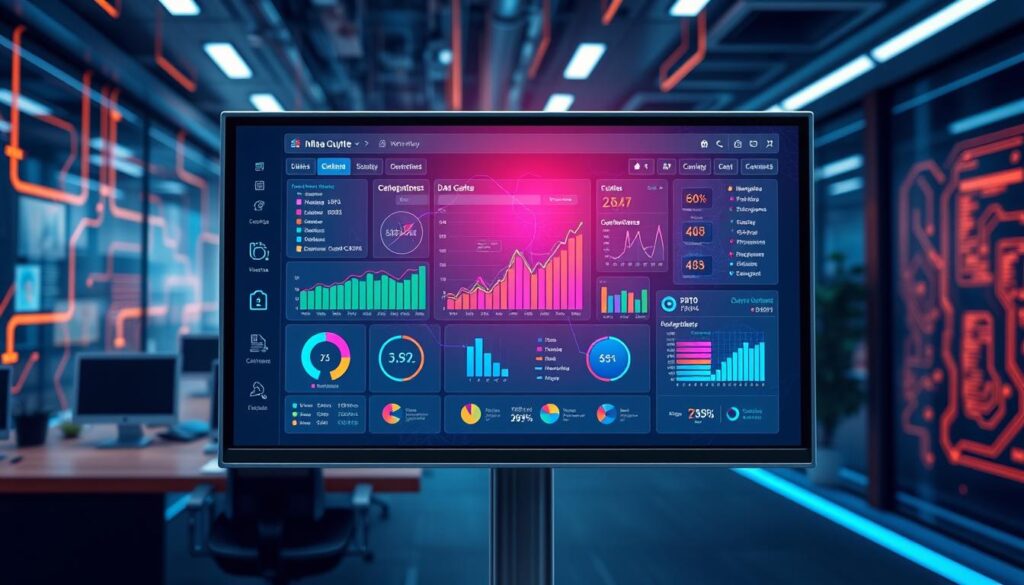FTC disclaimer: This post contains affiliate links and I will be compensated if you make a purchase after clicking on my link.
In today’s world, having good data is key for smart business choices. But with many data quality software choices, picking the right one can be tough. The best tools help keep your data reliable and trustworthy.
What should you look for in data quality software? How do you pick the best for your business? Our guide will help you find the top data quality software and what to look for.
Key Takeaways
- Choosing the right data quality software depends on your organization’s specific data needs, infrastructure, and goals.
- Data quality is a top priority for data teams, underscoring its critical importance for data-driven decision-making.
- Evaluating data quality is essential to transform raw data into actionable insights that drive business success.
- Data quality tools like dbt, Dagster, Amundsen, and DataHub play a crucial role in enhancing data reliability and accessibility.
- Collaborative governance tools, data testing frameworks, and data observability platforms are key to maintaining high data quality standards.
Importance of Data Quality
In today’s business world, high-quality data is key. It helps make smart choices that lead to success. But, keeping data quality up is hard for many companies.
Impact of Poor Data Quality on Business Decisions
Poor data quality hurts a company’s ability to make good choices. Gartner says bad data costs companies $12.9 million a year. IBM found that in 2016, data problems cost the U.S. $3.1 trillion. This shows how big the problem is.
Bad data can cause wrong analyses and poor plans. This can waste money, miss chances, and harm a company’s image.
Challenges of Maintaining High Data Quality
- Handling more and different data sources, each with its own problems.
- Keeping data accurate, complete, and consistent across systems.
- Following new data privacy laws, like GDPR and CCPA.
- Updating data quality for new tech, like AI and edge computing.
- Creating a data-focused culture and good data governance.
Keeping data quality high is a big challenge. It needs a complete effort from people, processes, and tech. By tackling these issues, companies can use their data better. This leads to smarter decisions and growth.

What are Data Quality Tools?
Businesses deal with huge amounts of data every day. Keeping this data accurate is key. Bad data can cause wrong decisions, waste money, and harm a company’s image.
A strong data quality toolkit is the answer. It’s a collection of software and methods to make sure data is right, consistent, and reliable. This toolkit helps keep data accurate and useful for making good choices.
Data quality tools help at every stage of data work. They check data when it comes in, changes, and when it’s used for decisions. Tools like data catalogs and version control help teams keep data in check.
A survey found 90% of data workers face delays because of bad data. Another survey said data quality is the most important goal for data teams in 2021. This shows how crucial data quality tools are today.
- Data Profiling and Analysis: Tools like Informatica and Talend Data Catalog help data practitioners understand the content, structure, and quality of their data, enabling them to make informed decisions.
- Data Cleansing and Standardization: Solutions from Precisely, Syniti, and Informatica offer features for data cleansing, de-duplication, and harmonization, ensuring consistency and reliability.
- Data Monitoring and Reporting: Collaborative analytics governance tools like Avo and Amplitude help teams monitor data quality, track lineage, and generate insightful reports.
Using a solid data quality toolkit lets companies use their data better. This leads to smarter choices, less waste, and growth.

Key Features to Look for in Data Quality Software
Finding the right data quality software is key for your data’s integrity. These tools help spot and fix errors in your data. This leads to better decision-making. Here are important features to look for:
Data Profiling and Analysis
Good data quality software should profile your data well. It helps find patterns and problems in your data. Look for tools that give detailed reports on your data’s health.
Data Cleansing and Standardization
After finding issues, your software should clean and standardize your data. It should fix duplicates, correct formatting, and add more information. The goal is to make your data reliable and useful.
Data Monitoring and Reporting
Keeping data quality up is constant. The best tools monitor and report on your data in real-time. They alert you to problems and let you create reports to show your efforts’ success.
Focus on these features to find a software that helps your business make smart choices. The right tools can make your data work for you, leading to better results.

Best Data Quality Software
Choosing the right data quality software is key to keeping your data accurate and reliable. Some tools focus only on data quality, but many are part of bigger platforms. These platforms also handle data integration, management, and more. We’ll look at the top tools for improving your data quality.
Some of the best data quality software solutions include:
- Deequ – An open-source library for defining “unit tests for data” to validate data quality and track data pipeline stability.
- dbt (Data Build Tool) – An open-source data transformation tool that enables you to write modular SQL code and test data quality as part of the deployment process.
- MobyDQ – An open-source data quality monitoring and alerting tool that focuses on four key indicators: completeness, freshness, latency, and validity.
- Great Expectations – A popular open-source data quality framework used by companies like Vimeo, Calm, and ING to identify, validate, and monitor data quality issues.
- Soda Core – An open-source data quality tool notable for its comprehensive test surface area coverage, supporting various data sources and connectors.
- Cucumber – While not directly a data quality tool, this open-source behavior-driven development framework allows for writing tests in plain English, making it accessible to non-technical users.
| Software | Composite Score | CX Score |
|---|---|---|
| PiLog Data Quality Management | 9.4 | 9.6 |
| SAS Data Quality | 9.2 | 9.3 |
| Talend Data Quality | 9.0 | 9.0 |
| SAP Data Services | 8.5 | 8.8 |
| Melissa Data Quality Suite | 8.3 | 8.6 |
| Alteryx | 8.2 | 8.5 |
| Zoominfo OperationsOS | 8.2 | 8.4 |
| Microsoft Data Quality Services | 8.3 | 8.3 |
| Oracle Enterprise Data Quality | 8.0 | 8.2 |
| Informatica Data Quality | 8.0 | 8.3 |
These tools offer many features. They help with data profiling, analysis, cleansing, monitoring, and reporting. This ensures your data is top-notch and helps you make better business choices.

Data Transformation Tools
Data transformation is key in the ETL or ELT process. It cleans, merges, and aggregates raw data. This makes the data useful for data scientists and analysts.
Choosing the right transformation framework is important. It greatly affects data quality in an organization.
dbt (Data Build Tool)
dbt helps data analysts manage the data analytics process. It lets them transform and model data. It also deploys code and creates documentation.
dbt is easy to use and powerful. It’s a top pick for data teams.
Dagster
Dagster is an open-source tool for ETL, ELT, and machine learning. It lets you create data pipelines. These can be tested and deployed anywhere.
Data transformation tools are vital for accurate data. They help make high-quality data for better business decisions. Picking the right tool, like dbt or Dagster, boosts your data capabilities.
Data Catalog Tools
Finding the right data sources is hard for organizations today. Data catalog tools help by managing metadata in one place. Amundsen and DataHub are leaders, making data governance and trust easier.
Amundsen: A Lightweight Approach to Data Discovery
Amundsen was made by Lyft’s team. It’s a platform for finding and managing data. It offers a Google-like search, helping users find data fast.
Its easy-to-use interface and data lineage features are why many choose it. It helps in making better decisions.
DataHub: Powering Enterprise-Wide Data Discovery
DataHub was started by LinkedIn’s team. It’s a top data catalog solution. It gives a full view of an organization’s data, helping users understand and manage it.
Its strong metadata management and support for many data sources make it great for big companies. It helps centralize data catalogs.
Data catalogs don’t manage data themselves but are key for trusted data access. Using Data Catalog Tools like Amundsen and DataHub helps organizations find insights. It improves governance and drives success.
“Data catalogs can improve data quality by 40%, enhancing decision-making processes and boosting return on investment.”
Instrumentation Management Tools
In the world of data-driven decision-making, the quality of the information is key. Instrumentation management tools are crucial. They make sure the data from different sources is good, tested, and managed well.
Avo: Collaborative Analytics Governance
Avo is a tool for working together on analytics. It helps product managers, developers, engineers, and data scientists. Avo offers tools for automated governance, real-time data checks, and more.
It ensures the data used for big business decisions is right and reliable.
Amplitude: Automated Data Governance
Amplitude is a top Instrumentation Management Tool. It lets data and product teams track quality data all the way through. Amplitude’s tools help keep data good and improve insights.
“Ensuring that the raw data (events) is clearly defined and tested, and the change management process is structured is a very effective way to improve data quality throughout the entire stack.”
Using Instrumentation Management Tools like Avo and Amplitude helps businesses. It makes data governance smoother, lowers the chance of bad data, and leads to better decisions.
Data Governance and Lineage Tracking
In today’s world, data governance is key for businesses to use their data well. It’s about how data is gathered, handled, kept safe, and shared. Good data governance means data is ready to use and follows the rules.
Data lineage tracking shows how data moves in a company. It helps keep data quality high, follow rules, and make smart choices.
Here are some top data governance and lineage tracking tools for better data management:
- Alation Data Governance App: Started in 2012, Alation launched a data governance tool in September 2021. It helps users understand their data better.
- Ataccama One: This platform combines data governance, quality, and more into one solution.
- Apache Atlas: Made for Hadoop clusters, Apache Atlas helps with data governance through a flexible system.
- Axon Data Governance: Using AI, Axon helps data stewards find and share data, making governance easier.
- Collibra Data Governance: Collibra makes data governance work better, helps everyone talk about data, and makes data easier to use.
These tools, like Precisely Data Integrity Suite and Erwin Data Intelligence, show how important data governance and lineage tracking are today. Using them can improve data safety, follow rules, and make better decisions. This helps businesses get more value from their data.
Data Testing Frameworks
In today’s world, having good data is key. Data testing frameworks help find and fix data problems early. They help teams make data products they can trust.
These frameworks check for things like missing data and make sure data is up to date. They also look at numbers to make sure they’re right.
dbt’s Testing Framework
dbt is a tool for working with data. It has a built-in way to test data. This lets teams build reliable data pipelines from the start.
dbt’s tests include checking data safely and making fake data to help. It also tracks tests and lets you add proof to them. You can see tests as they happen and track how long they take.
Great Expectations
Great Expectations is another tool for testing data. It has lots of tests for data quality. It helps teams really understand their data.
Great Expectations makes testing faster and tracks data changes. It also works well with many data tools. This helps catch more problems and work better with other tools.
| Test Data Management Solution | Average Rating |
|---|---|
| Tonic.ai | 4.5 |
| K2View | 4.4 |
| IBM Optim | 4.35 |
| Informatica Test Data Management | 4.1 |
| Delphix | 4.05 |
Tools like dbt and Great Expectations help a lot. But, as your data grows, you’ll need something more. You’ll need a solution that covers all of your data’s life.
Data Discovery and Cataloging Solutions
In today’s fast-changing data world, data discovery and data cataloging tools are key. They help organizations use their data to its fullest. These tools use metadata to show what data an organization has. This makes it easier for people to find and use the data.
Data discovery and cataloging tools light up the “dark corners” of data. They show how data is connected and moves through systems. This makes it simple for data teams to find important data.
But, these tools don’t check if the data is good or reliable. To trust the data, organizations must also focus on data quality and governance.
Popular Open-Source Data Catalog Tools
- Amundsen
- Atlas
- DataHub
- Marquez
- OpenDataDiscovery
- OpenMetadata
These open-source tools help manage metadata and make data easier to find. Companies like Atlan and Uber use them to improve their data management.
Key Features and Benefits of Data Catalog Tools
When choosing data catalog tools, look for features like automated discovery and good metadata management. Also, advanced data classification and tracking are important. A strong data catalog makes data easier to find and use, leading to better business decisions.
A good data catalog helps with data policies, makes data easier to find, and improves data quality. It also helps with data security and following rules. This makes data management better and safer.
As the data catalog market grows, more organizations see how important these tools are. They help make data-driven decisions and unlock data value.
Data Contracts and Standards
In today’s world, data moves fast across many systems and teams. Keeping data quality high is a big challenge. Data contracts help solve this problem. They are agreements between those who make data and those who use it, setting rules for data sharing.
Data contracts help keep data the same and useful for others. They help teams work together better. This includes using the same ways to log data and meet certain data needs.
Even with data contracts, data can still go wrong. It’s important to have ways to find and fix these problems. Data standards are key here. They give a clear way to manage and govern data.
Data standards make sure data is the same everywhere in a company. This helps teams work together better and share data easily. Following these standards helps improve data quality and makes better decisions.
Using both data contracts and standards is a strong way to keep data good and help a company succeed. They set clear rules, check data quality, and make sure data is used the right way. This helps teams work well together and give valuable insights to others.
| Data Contracts | Data Standards |
|---|---|
| Establish formal agreements between data producers and consumers | Provide a standardized framework for data management and governance |
| Define rules, constraints, and expectations around data exchange and utilization | Ensure consistent data structure, formatting, and definitions across the organization |
| Promote data consistency and usability for downstream users | Enhance interoperability, collaboration, and efficient data exchange |
| Align teams around data extraction, ingestion, ownership, and access requirements | Improve data quality and decision-making capabilities |
By using data contracts and data standards, companies can handle today’s data challenges. They keep data reliable and unlock its full value.
Data Observability Platforms
Data observability platforms are changing how we manage data. They use automation for testing, monitoring, and alerting. They also track data lineage to quickly solve data problems.
These platforms fix old data quality issues. They save money, speed up data use, and solve problems faster.
Observability uses machine learning to start monitoring right away. It also gives custom insights and easy coding tools. This makes testing easier for users.
It also helps find problems fast with automated lineage. This lets teams quickly see what’s wrong and how to fix it.
Tools like Elementary, Soda, Great Expectations, Sifflet, and Anomalo are popular. They became important in 2021 because they solve data problems quickly.
These tools work with many data tools. They have services for moving data, storing metadata, and alerting users.
New tools like Open Metadata have cool features. But, they are not used by many yet.
Most tools also track data lineage and logs. This helps with debugging and audits.
There are also big observability solutions. Appdynamics Business Observability Platform, Amazon CloudWatch, and Datadog Observability Platform are examples. They monitor many IT parts, including data.
“Data observability solutions use automation to deliver comprehensive testing, monitoring and alerting, and lineage to facilitate swift resolution — in a single platform.”
Conclusion
Data quality is very important for companies in many fields. If your business uses data for products or decisions, it must be accurate and reliable. A good data quality toolkit is needed from start to finish to keep data trustworthy.
Data quality and governance go hand in hand. Tools like data discovery tools help improve data quality. A strong toolkit boosts decision-making, efficiency, and confidence in your data.
It’s clear that data quality is essential for success in today’s world. Using the right tools and strategies can unlock your data’s full potential. This will help your business grow.








